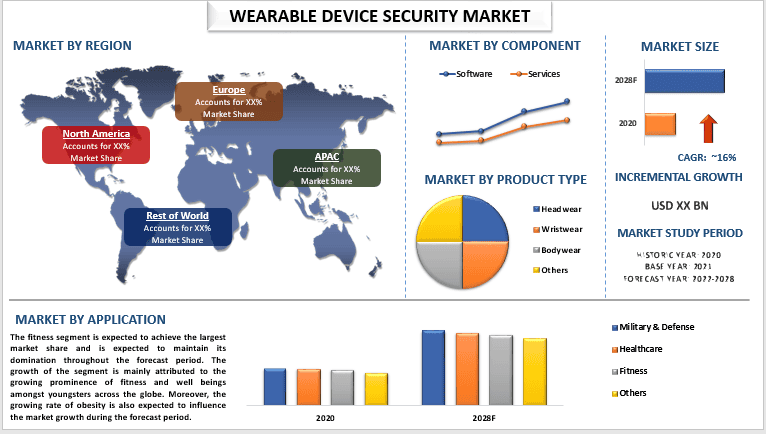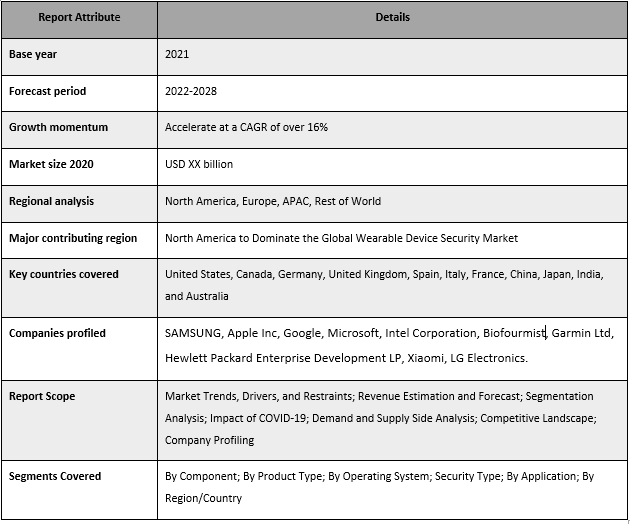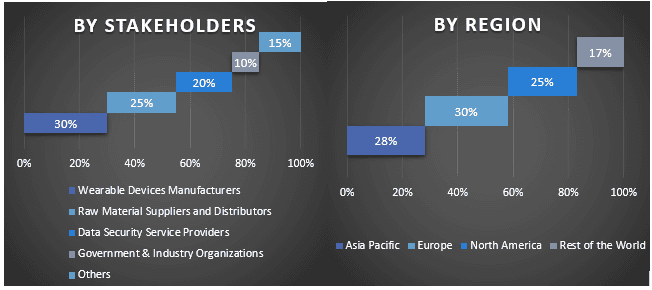- Home
- Chi siamo
- Settore
- Servizi
- Lettura
- Contattaci
Mercato della sicurezza dei dispositivi indossabili: analisi attuale e previsioni (2022-2028)
Enfasi sul Componente (Software e Servizi); Tipo di Prodotto (copricapo, dispositivi da polso, indumenti e altri); Sistema Operativo (Apple Watch OS, Wear OS, Fitbit OS, Garmin OS e Altri); Tipo di Sicurezza (Sicurezza Cloud, Sicurezza di Rete, Sicurezza Wireless e Sicurezza delle Applicazioni); Applicazione (Militare & Difesa, Sanità, Fitness e Altri); Regione/Paese.

RICHIEDI UN PDF DI ESEMPIO GRATUITO
Si prevede che il mercato globale della sicurezza dei dispositivi indossabili crescerà a un tasso significativo di circa il 16% durante il periodo di previsione 2022-2028. La tecnologia indossabile, spesso nota come gadget indossabili, si riferisce a una classe di dispositivi tecnologici a bassa capacità di elaborazione che possono essere indossati da un utente e sono progettati per fornire informazioni e comodità di accesso alle macchine master a cui sono abbinati. Gli smartwatch e i Google Glass sono due esempi di questo tipo. La sicurezza dei dispositivi indossabili include la sicurezza del cloud, la sicurezza delle applicazioni, la sicurezza della rete e altri tipi. La ricerca rivela che i prodotti per la sicurezza del cloud e delle applicazioni sono particolarmente popolari oggi grazie alla loro vasta gamma di funzionalità di sicurezza.
La crescita del mercato è principalmente attribuita alla crescente importanza della salute e del fitness in tutte le regioni. Inoltre, si prevede che l'aumento del tasso di popolazione e la crescente importanza di Internet guideranno il mercato durante il periodo di previsione. Ad esempio, secondo la ricerca sulla banda larga, più del 93% del Nord America è su Internet. Inoltre, si prevede che la crescente importanza dell'IoT influenzerà in modo significativo la crescita del mercato durante il periodo di previsione.
SAMSUNG, Apple Inc, Google, Microsoft, Intel Corporation, Biofourmis, Garmin Ltd, Hewlett Packard Enterprise Development LP, Xiaomi e LG Electronics sono alcuni dei principali operatori del mercato. Diverse fusioni e acquisizioni insieme a partnership sono state intraprese da questi operatori per fornire ai clienti prodotti/tecnologie hi-tech e innovativi.
Approfondimenti presentati nel rapporto
"Tra i componenti, la categoria software deterrà una quota significativa del mercato nel 2020"
Sulla base dei componenti, il mercato è suddiviso in software e servizi. Si prevede che il segmento software raggiungerà la quota di mercato maggiore nel 2020 e dovrebbe mantenere il suo dominio per tutto il periodo di previsione. La crescita del segmento è principalmente attribuita alle sue caratteristiche come il pagamento una tantum, migliori servizi di supporto, accesso firewall in tempo reale, ecc. Inoltre, si prevede che la crescente necessità di una sicurezza efficiente dei dati indossabili guiderà il mercato durante il periodo di previsione.
Copertura del rapporto sul mercato della sicurezza dei dispositivi indossabili

"Tra i tipi di prodotto, il segmento dei dispositivi da polso deterrà una quota significativa del mercato nel 2020"
Sulla base del tipo di prodotto, il mercato è suddiviso in dispositivi da testa, dispositivi da polso, dispositivi da corpo e altri. Si prevede che il segmento dei dispositivi da polso assisterà alla maggiore quota di mercato durante il periodo di previsione. La crescita è principalmente attribuita ai progressi nelle tecnologie e alle innovazioni. Ad esempio, a settembre 2022, Apple ha presentato l'Apple Watch Series 8, con molte funzionalità avanzate come una durata della batteria di 18 ore, l'app ECG, il rilevamento delle cadute, ecc. Inoltre, si prevede che la crescente implementazione di funzionalità per la salute come il sensore spo2 guiderà la crescita del mercato durante il periodo di analisi.
"Il Nord America deterrà una quota significativa del mercato"
Si prevede che la regione del Nord America raggiungerà la quota di mercato maggiore della sicurezza dei dispositivi indossabili e dovrebbe mantenere il suo dominio per tutto il periodo di previsione. La crescita nella regione è principalmente attribuita alla crescente domanda di dispositivi indossabili nella regione. Inoltre, si prevede che la crescente prevalenza dei pagamenti costanti influenzerà la crescita del mercato durante il periodo di previsione. Inoltre, si prevede che la presenza di attori chiave come Apple e Microsoft nella regione guiderà anche il mercato durante il periodo di previsione.
Motivi per acquistare questo rapporto:
- Lo studio include l'analisi della dimensione del mercato e delle previsioni convalidate da esperti chiave del settore autenticati.
- Il rapporto presenta una rapida revisione della performance complessiva del settore a colpo d'occhio.
- Il rapporto copre un'analisi approfondita dei principali concorrenti del settore con un focus primario sui principali dati finanziari aziendali, sul portafoglio prodotti, sulle strategie di espansione e sugli sviluppi recenti.
- Esame dettagliato dei driver, dei vincoli, delle tendenze chiave e delle opportunità prevalenti nel settore.
- Lo studio copre in modo completo il mercato in diversi segmenti.
- Analisi approfondita a livello regionale del settore.
Opzioni di personalizzazione:
Il mercato globale della sicurezza dei dispositivi indossabili può essere ulteriormente personalizzato in base alle esigenze o a qualsiasi altro segmento di mercato. Oltre a questo, UMI comprende che potresti avere le tue esigenze aziendali, quindi sentiti libero di metterti in contatto con noi per ottenere un rapporto che si adatti completamente alle tue esigenze.
Indice
Metodologia di ricerca per l'analisi del mercato della sicurezza dei dispositivi indossabili (2022-2028)
L'analisi del mercato storico, la stima del mercato attuale e la previsione del mercato futuro del mercato globale della sicurezza dei dispositivi indossabili sono stati i tre passaggi principali intrapresi per creare e analizzare l'adozione della sicurezza dei dispositivi indossabili nelle principali regioni a livello globale. È stata condotta un'esaustiva ricerca secondaria per raccogliere i dati storici del mercato e stimare le dimensioni attuali del mercato. In secondo luogo, per convalidare queste informazioni, sono state prese in considerazione numerose scoperte e ipotesi. Inoltre, sono state condotte anche interviste primarie esaustive con esperti del settore lungo tutta la catena del valore del mercato globale della sicurezza dei dispositivi indossabili. Dopo l'assunzione e la convalida dei dati di mercato attraverso interviste primarie, abbiamo impiegato un approccio top-down/bottom-up per prevedere le dimensioni complete del mercato. Successivamente, sono stati adottati metodi di scomposizione del mercato e triangolazione dei dati per stimare e analizzare le dimensioni del mercato dei segmenti e sottosegmenti del settore di riferimento. La metodologia dettagliata è spiegata di seguito:
RICHIEDI UN PDF DI ESEMPIO GRATUITO
Analisi delle dimensioni storiche del mercato
Fase 1: Studio approfondito delle fonti secondarie:
È stato condotto uno studio secondario dettagliato per ottenere le dimensioni storiche del mercato della sicurezza dei dispositivi indossabili attraverso fonti interne aziendali come relazioni annuali e bilanci, presentazioni sulle prestazioni, comunicati stampa, ecc. e fonti esterne tra cui riviste, notizie e articoli, pubblicazioni governative, pubblicazioni dei concorrenti, relazioni di settore, database di terze parti e altre pubblicazioni credibili.
Fase 2: Segmentazione del mercato:
Dopo aver ottenuto le dimensioni storiche del mercato della sicurezza dei dispositivi indossabili, abbiamo condotto un'analisi secondaria dettagliata per raccogliere informazioni storiche sul mercato e condividere per diversi segmenti e sottosegmenti per le principali regioni. I segmenti principali inclusi nel report sono componente, tipo di prodotto, sistema operativo, tipo di sicurezza e applicazione. Ulteriori analisi a livello di paese sono state condotte per valutare l'adozione complessiva dei modelli di test in quella regione.
Fase 3: Analisi dei fattori:
Dopo aver acquisito le dimensioni storiche del mercato di diversi segmenti e sottosegmenti, abbiamo condotto un'analisi dettagliata dei fattori per stimare le dimensioni attuali del mercato della sicurezza dei dispositivi indossabili. Inoltre, abbiamo condotto un'analisi dei fattori utilizzando variabili dipendenti e indipendenti come componente, tipo di prodotto, sistema operativo, tipo di sicurezza e applicazione. della sicurezza dei dispositivi indossabili. È stata condotta un'analisi approfondita per scenari di domanda e offerta considerando le principali partnership, fusioni e acquisizioni, espansioni aziendali e lanci di prodotti nel settore del mercato della sicurezza dei dispositivi indossabili in tutto il mondo.
Stima e previsione delle dimensioni attuali del mercato
Dimensionamento attuale del mercato: sulla base di informazioni utili dalle 3 fasi precedenti, siamo giunti alle dimensioni attuali del mercato, ai principali operatori nel mercato globale della sicurezza dei dispositivi indossabili e alle quote di mercato dei segmenti. Tutte le quote percentuali richieste e le suddivisioni del mercato sono state determinate utilizzando l'approccio secondario sopra menzionato e sono state verificate attraverso interviste primarie.
Stima e previsione: per la stima e la previsione del mercato, sono stati assegnati pesi a diversi fattori tra cui driver e tendenze, vincoli e opportunità disponibili per le parti interessate. Dopo aver analizzato questi fattori, sono state applicate le tecniche di previsione pertinenti, ovvero l'approccio top-down/bottom-up, per arrivare alla previsione di mercato per il 2028 per diversi segmenti e sottosegmenti nei principali mercati a livello globale. La metodologia di ricerca adottata per stimare le dimensioni del mercato comprende:
- Le dimensioni del mercato del settore, in termini di ricavi (USD) e il tasso di adozione del mercato della sicurezza dei dispositivi indossabili nei principali mercati nazionali
- Tutte le quote percentuali, le suddivisioni e le ripartizioni dei segmenti e sottosegmenti di mercato
- Operatori chiave nel mercato globale della sicurezza dei dispositivi indossabili in termini di prodotti offerti. Inoltre, le strategie di crescita adottate da questi operatori per competere nel mercato in rapida crescita
Convalida delle dimensioni e della quota di mercato
Ricerca primaria: sono state condotte interviste approfondite con i Key Opinion Leaders (KOL) tra cui dirigenti di alto livello (CXO/VP, responsabile delle vendite, responsabile del marketing, responsabile operativo, responsabile regionale, responsabile nazionale, ecc.) nelle principali regioni. I risultati della ricerca primaria sono stati quindi riepilogati ed è stata eseguita un'analisi statistica per dimostrare l'ipotesi dichiarata. I dati della ricerca primaria sono stati consolidati con i risultati secondari, trasformando così le informazioni in informazioni utili.
Suddivisione dei partecipanti primari nelle diverse regioni

Ingegneria di mercato
È stata impiegata la tecnica di triangolazione dei dati per completare la stima complessiva del mercato e per arrivare a numeri statistici precisi per ogni segmento e sottosegmento del mercato globale della sicurezza dei dispositivi indossabili. I dati sono stati suddivisi in diversi segmenti e sottosegmenti dopo aver studiato vari parametri e tendenze nelle aree di componente, tipo di prodotto, sistema operativo, tipo di sicurezza e applicazione nel mercato globale della sicurezza dei dispositivi indossabili.
L'obiettivo principale dello studio sul mercato globale della sicurezza dei dispositivi indossabili
Le tendenze attuali e future del mercato globale della sicurezza dei dispositivi indossabili sono state individuate nello studio. Gli investitori possono ottenere informazioni strategiche per basare la propria discrezione per gli investimenti sull'analisi qualitativa e quantitativa eseguita nello studio. Le tendenze attuali e future del mercato hanno determinato l'attrattiva complessiva del mercato a livello regionale, fornendo una piattaforma per il partecipante industriale per sfruttare il mercato non sfruttato per beneficiare di un vantaggio di pioniere. Altri obiettivi quantitativi degli studi includono:
- Analizzare le dimensioni del mercato attuale e previsto del mercato della sicurezza dei dispositivi indossabili in termini di valore (USD). Inoltre, analizzare le dimensioni del mercato attuale e previsto di diversi segmenti e sottosegmenti
- I segmenti nello studio includono aree di componente, tipo di prodotto, sistema operativo, tipo di sicurezza e applicazione.
- Definire e analizzare il quadro normativo per la sicurezza dei dispositivi indossabili
- Analizzare la catena del valore coinvolta con la presenza di vari intermediari, insieme all'analisi del comportamento dei clienti e dei concorrenti del settore.
- Analizzare le dimensioni del mercato attuale e previsto del mercato della sicurezza dei dispositivi indossabili per la regione principale.
- I principali paesi delle regioni studiati nel rapporto includono Asia Pacifico, Europa, Nord America e il resto del mondo.
- Profili aziendali del mercato della sicurezza dei dispositivi indossabili e le strategie di crescita adottate dagli operatori di mercato per sostenersi nel mercato in rapida crescita
- Analisi approfondita a livello regionale del settore
Correlati Report
I clienti che hanno acquistato questo articolo hanno acquistato anche










